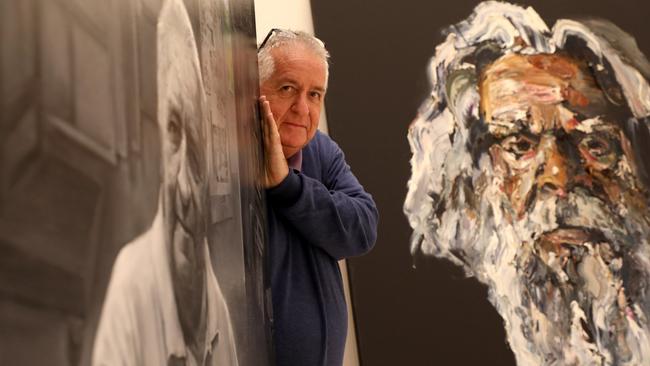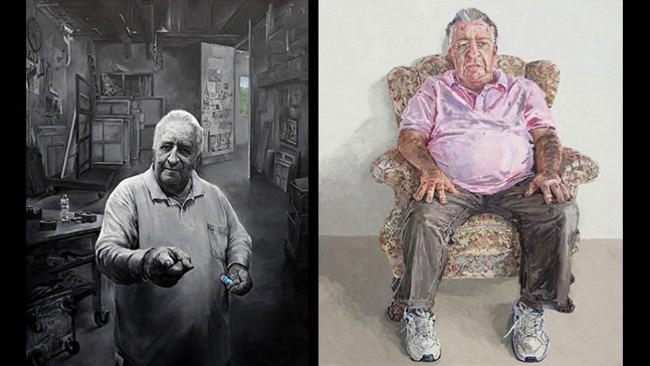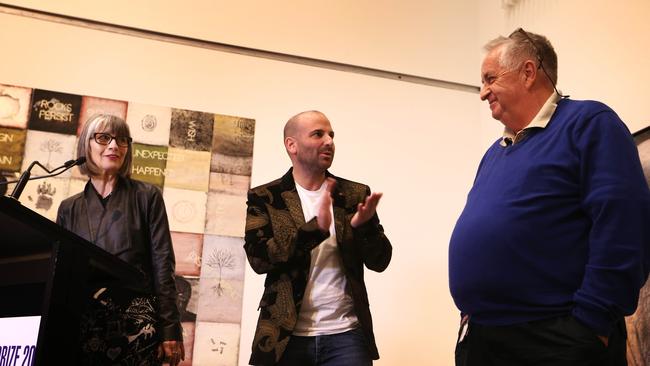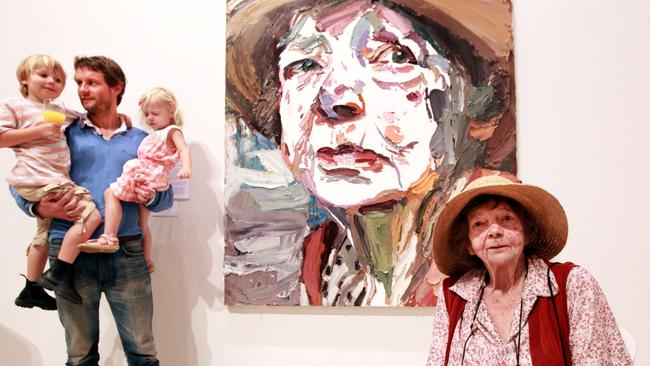AGNSW’s chief packer Steve Peters to retire after Archibald Prize
After 34 years as the Art Gallery of NSW’s chief packer, Steve Peters is unwrapping his last Archibald Prize entries.

“It would be nice if we had a touring exhibition of Packing Room Prize winners all around Australia, and I could go on the junket — I mean the educational tour,” says Steve Peters. “They could bill it as ‘What portraits are supposed to look like’.”
On the Monday morning of the craziest week of the year at the Art Gallery of NSW — Archibald submissions week — Peters is the quiet, no-nonsense eye of the hurricane. In his trademark pink shirt and with Mentos to hand, the packer-in-chief has been here since 5.30am and will put in 12-hour days for the final time. After handling — and fearlessly judging — tens of thousands of portraits of Australian celebrities during his career, he is also unwrapping not one but two portraits of himself. One of them is set here, in the confines of the gallery, surrounded by art, while the other came to life over two days in a very different environment, several hours away. The subject of both portraits has found himself in the spotlight because he’s retiring after 34 years in the job, and 26 as the all-powerful judge of the Archibalds’ famous consolation, the Packing Room Prize.

“The last thing I ever want to see again is a piece of bubble wrap,” says Peters, 60, who is craving sleep-ins, time with his grandchildren, golf and travel. He has in fact just returned from five weeks in Europe: London, Berlin, Florence, Venice, Ljubljana, Paris, Avignon, Lyons, Salzburg. Food and wine were the focus — not art. “Bah. You’ve seen one piece of art, you’ve seen ’em all, right?” he says with a wink.
By the end of the week 2154 canvases will have arrived for the Archibald (portrait), Wynne (landscape) and Sulman (genre, subject or mural) painting prizes. Some others inevitably will arrive at deadline on Friday afternoon, still wet, and be rejected.
All the rest have to be catalogued, presented for judging and kept track of, the rejects collected, the finalists eventually transported off-site, repacked and shipped back to the artists (preferably the ones who painted them — “they get a bit funny otherwise”).

In the ballet of flying dollies and floating bubble wrap, it’s portraits with instant impact that win the approval of the packers. They always had their favourites, Peters says, but the Packing Room Prize became a thing back in 1992 when SH Ervin Gallery came to harvest paintings for its Salon des Refuses show.
“We had this big picture of [former Labor foreign minister] Gareth Evans resting against the door. They came in and said, ‘Well that’s out for a start.’ I said, as a throwaway line, ‘You’re kidding — that won the packing room prize.’ Well bugger me, they picked it [as a finalist].
“The next day, publicity here said: ‘Tomorrow you’re going to be on the Andrew Olle breakfast show.’ I thought, ‘Bloody hell, I’ve opened my big mouth here.’ ”
The Archibald Prize attracts some “serious” art, and also much of what The Australian’s notoriously stringent critic Christopher Allen describes frankly as “kitsch”.
But Peters knows what he likes and has a refreshingly unselfconscious set of criteria for good portraiture. He gives short shrift to the abstract, the obscure, the unrecognisable.
“For us here in the packing room the work has got to look like the subject, and the subject has to be someone popular who the average Joe can recognise: there’s some wonderful paintings made of doctors, whoever, that are wonderful works but the average person wouldn’t know who they are. But No 1, the work’s got to be good, which knocks out 94 per cent of them.” The common touch? “More a commonsense touch,” he says.
Of the AGNSW’s permanent collection, he loves the old Australian galleries best. “Not a fan of contemporary art. We had a Biennale here one year and silly bloody Yoko Ono put in these bloody trees. We had them in rows. We looked like a franchise of Flower Power.”
“Silly” entries to the Archibald, Wynne and Sulman have been numerous. Sometimes, he says, “you shake your head and think, ‘mate’ ”.
“There are some very nice artists and some who are well switched on. But some are just in another world: they don’t read instructions, they come in with a painting that’s still wet, they leave hooks on the back of the work, then they come in and want their photo taken with their work — hold up everything in here while you take their photograph. Hello? It’s on every year, you’ve had 12 months to do it — take your bloody photo first.
“That’s what you say to yourself, anyway. We try to be as obliging as we can.”
But it’s the palaver with trucks and dollies and packing tape and bubble wrap and artists’ demands that make the prize special (well, that and the money attached: $100,000 for the Archibald, $50,000 for the Wynne, $40,000 for the Sulman). It’s the only art prize in Australia judged in person without any reference to digital copies, says AGNSW head of exhibitions Charlotte Cox.
“Others are judged on a jpeg at first and cut down to a shortlist, which is then viewed in person, but this is the only prize in Australia that is judged in person from the get go,” Cox says. “You can’t see scale or texture or true colour [in a jpeg] and sometimes it’s those nuances that make a work really special. Like the portrait of Barry Humphries [last year’s Archibald winner by Louise Hearman] that had a little sequin on his eyebrow that sparkled in the right light — you never pick that up in a digital image.
“It’s an expensive venture to get the work here, but to have each work judged by the panel is so important, and it’s just fairer.”
The Packing Room Prize, worth $1500 to the winner since 2010, is announced before the official Archibald winner, and carries a terrible curse: no painting has won both. Sometimes Peters’ choice isn’t even a finalist.
But he laughs off the “kiss of death” label. “Since we’ve started picking it, the trustees have got better and they’ve been picking ours as well as finalists. They used to hang PRP around the corner. But I’m pleased to say the last dozen or 15 years our pick has been in the show. So I think the trustees are learning, which is great.”
Tim Storrier has won both prizes, though not in the same year. He won the Archibald in 2012 for his highly detailed, surreal, faceless self-portrait The Histrionic Wayfarer (after Bosch), and the Packing Room Prize two years later with his contrastingly earthy The Member, Dr Sir Leslie Colin Patterson KCB AO.
“It’s a bit of a mixed feeling because no one who has won the Packing Room Prize has won the Archibald at the same time,” Storrier says. “Having said that, it’s a lovely thing to win. Its great value is that it gets a lot of interest from the public. People who aren’t art professionals can have a very distinct view of things.”
Storrier, who is entering the prize again this year with a portrait of fellow painter McLean Edwards, says there’s no mistaking the chief packer’s authority.
“Don’t underestimate Steve Peters. [Former director] Edmund Capon is under the impression that he ran the gallery for 30 years when everybody knew it was Steve Peters who ran the place. It was also known that [former chairmen] David Gonski and Frank Lowy never made a decision without visiting Steve secretly to see what he thought.”
Capon himself — whom Peters calls a “lovely bloke, super boss” — echoes the warning: “Dear Steve is the unchallenged master of the Archibald. Pity the poor artist who turns up with a picture that the master deems inadequate. One withering glance from the great connoisseur will denounce it as rubbish. And trustees beware … it’s Steve’s opinion that really counts.”
This year two artists have been brave enough to take on this fearsome critic as a subject. It is something Peters seems to find genuinely baffling. “If I was an artist I wouldn’t want to paint me! It was lovely to be asked and an honour to be asked by two such accomplished painters. Hopefully the trustees like them. I think they’re terrific — two great-looking portraits, and so different.”
Lucy Culliton, a regular finalist in all three prizes, painted him at her property in Bibbenluke, six hours south of Sydney, across two days. He sat in the morning and watched her feed her menagerie of farm animals in the afternoon.
“I’m not brave in asking people to sit for me, but when I talked to Steve he was so lovely on the phone and he was prepared to come down to me,” Culliton says. “We just got on really well. He’s just a really good bloke: really into life, a little bit sporty.
“He asked what he should wear, and I said whatever you’re comfortable in. So he turned up with six pink shirts.”
Tianli Zu, by contrast, painted her near-monochrome photoreal portrait — featuring the Mentos — in Peters’ den. She had met him when submitting her portrait of Capon last year.
“I knew he’d have lots of untold stories,” she says. “I was just curious to find out and the only way to find out is to paint him.
“He said I’ll come to your studio and sit for you, and I said, ‘No, no Steve, it’s about you, it’s not about me. Show me where you belong. So he took me to the packing room, he showed me how he works and I observed him very closely. He has this kind of passion coming through how he works. He’s really humble, he’s just wonderful.
“He leaves a legacy behind him — the relationship of the art to the people, museum and community. They come to see the celebrities, and now he’s a celebrity himself.”
It’s not even the first time Peters has been painted: in the packing room hangs another portrait of him, with a little more hair, by Bundaberg artist Dave Machen. Though he has always claimed 51 per cent of the Packing Room Prize vote, the only time Peters put his foot down was when his staff wanted to give the prize to Machen.
Peters will leave the packing room — and the prize — in the hands of Brett Cuthbertson, who has worked there even longer: 36 years. There won’t be too many changes, although he plans to cement his new authority by taking 52 per cent of the vote.
“It’s the best time of the year,” Cuthbertson says of Archibald season. “The most tiring time of the year, but fun. It’s like a circus. You get all sorts of people, people who can paint, people who can’t — they don’t care, they just want to be part of it. That’s the fun of it.”
His even more succinct set of rules for the Packing Room Prize: “It can’t be rubbish.”
Peters, who received the Public Service Medal last year, worked as a storeman and forklift driver for the Government Printing Office before his job at AGNSW.
The lifelong St George fan and keen golfer grew up in Monterey in the south of Sydney, the son of an Ansett engineer. He was “hopeless at school — the Marist Brothers Kogarah wouldn’t be proud to say I went there”, and says art was not a big thing for him growing up.
“I can’t even draw stick people,” he says. “But working here I’ve got an appreciation of art. I’ve been fortunate enough to unpack Monet works — Monet to me is just beautiful. When you’re the first to open a crate, it’s quite surreal. You think, ‘Boy, I’m holding this art worth millions!’
“The [Terracotta] Warriors we’ve had as well — I lifted them out. Incredible stuff. Picasso, Van Gogh. I’ve touched them while everyone else has to stand behind a barrier.”
It’s been a great career, he says. He gets a little misty-eyed at the thought of leaving, not so much the job but his colleagues. “All these guys here,” he says, looking around. “I feel lucky to have had a job, one, but also to work with such lovely people. It has been a dream job. But this time next year I’ll still be in bed.”
***

DAUNTING SPECTACLE FOR A LUCKY FEW
“Winning the Archibald means a lot. It meant a lot to me, but it can be a complete life-changer for an artist that hasn’t been exhibiting for years. An outsider. In fact, it can be the beginning and the end for an uninitiated artist! We spend all our time, mostly alone, pondering the world from inside small white rooms thick with the scent of oil paint and turps. So to be thrust in front of the country’s viewing public, media and critics is completely daunting.”
So says Ben Quilty, one of the nation’s best known artists, as he looks back at his Archibald win. It was 2011, and Quilty had taken out the prize for a portrait of the ebullient painter Margaret Olley, his friend and mentor.
Quilty’s profile had been rising: he had won the Doug Moran Portrait Prize two years earlier for a picture of Jimmy Barnes, and had been selected as an Archibald finalist six times before. But as every artist knows, or soon finds out, winning the Archibald is an experience like no other.
But why does a prize devoted to portraits painted from life attract so much fuss every year? For the transient popularity, the prize is sometimes compared with the Melbourne Cup: it’s the one day in the year when the national conversation turns to the business of art. Perhaps it has something to do with accessibility: familiar faces, and a familiar medium.
Either way, it’s not about the money. Archibald winners receive $100,000. That figure has been growing — Quilty’s win six years ago earned him $50,000 — but it’s not Australia’s richest art prize. (The Moran offers $150,000.)
It’s not necessarily about critical prestige either, since there’s always robust debate about the finalists and winners. Some years, though, the winner is a popular choice (even if the actual People’s Choice goes elsewhere): Quilty’s Olley seemed destined to win, as did Nigel Milsom’s portrait of lawyer Charles Waterstreet in 2015.
The Archibald comes, of course, with a rich history, and plenty of controversy: William Dobell’s 1943 portrait of fellow artist Joshua Smith ended up in court; in 1952, a young John Olsen led a protest over yet another conservative winner; in 1978, Brett Whiteley won for a triptych about drug addiction, and simultaneously became the first artist to win the Archibald, Wynne and Sulman prizes in the same year.
The prize, courtesy of a bequest from The Bulletin editor JF Archibald, was first awarded in 1921. It is now in its 96th year. This year’s finalists will be announced on Thursday and the overall winners the following week.
The Packing Room Prize, along with the Archibald, Wynne and Sulman finalists, will be announced on Thursday at the Art Gallery of NSW, then on display from July 29 to October 22.


To join the conversation, please log in. Don't have an account? Register
Join the conversation, you are commenting as Logout